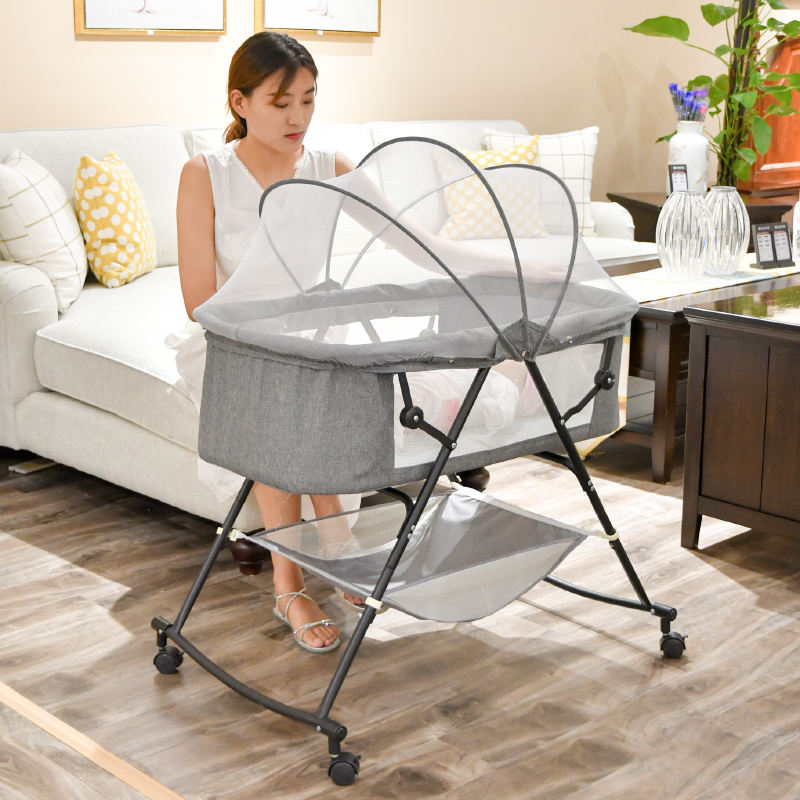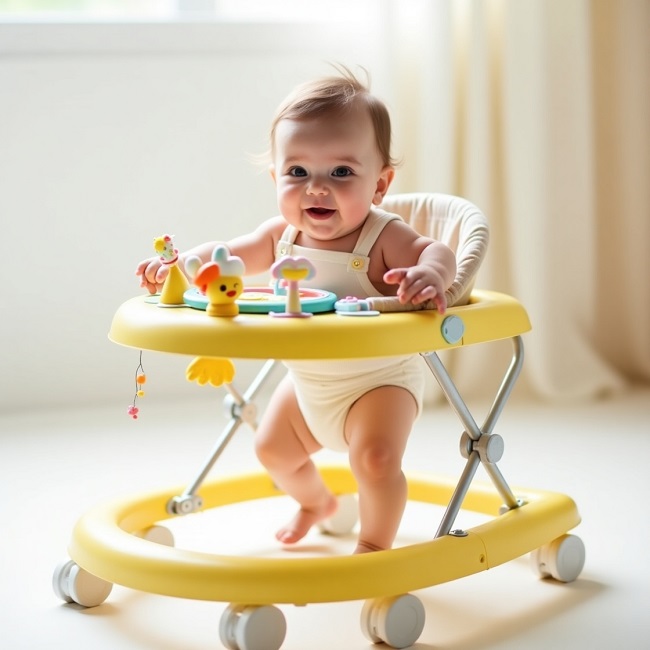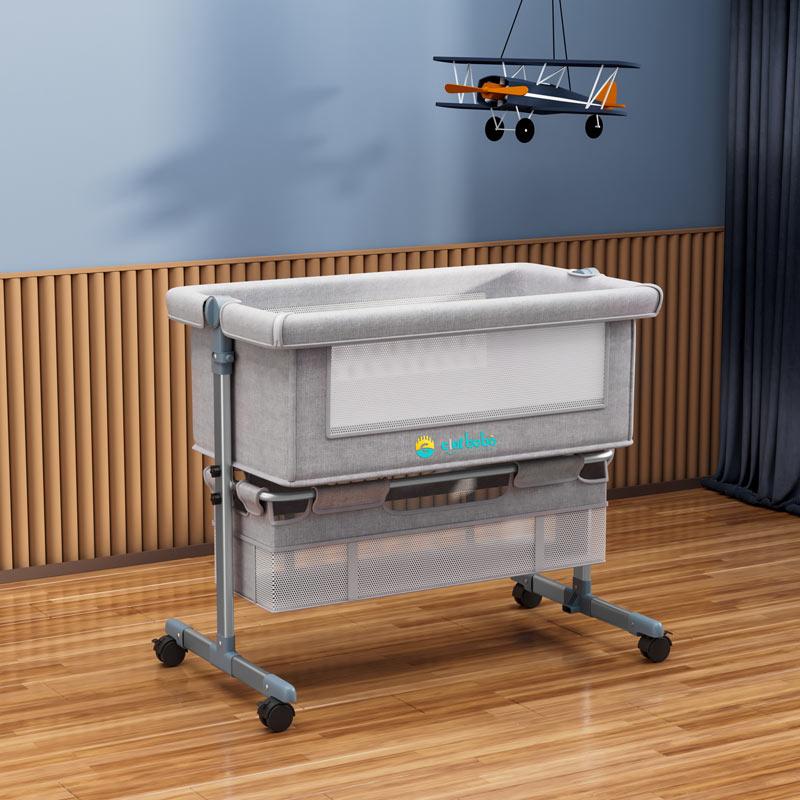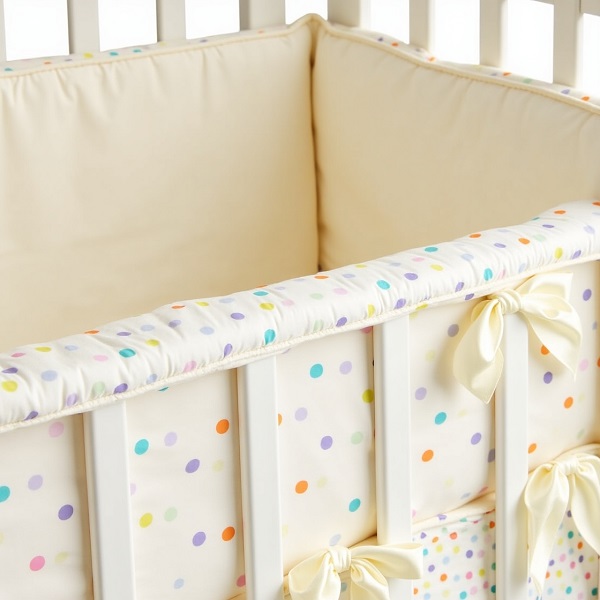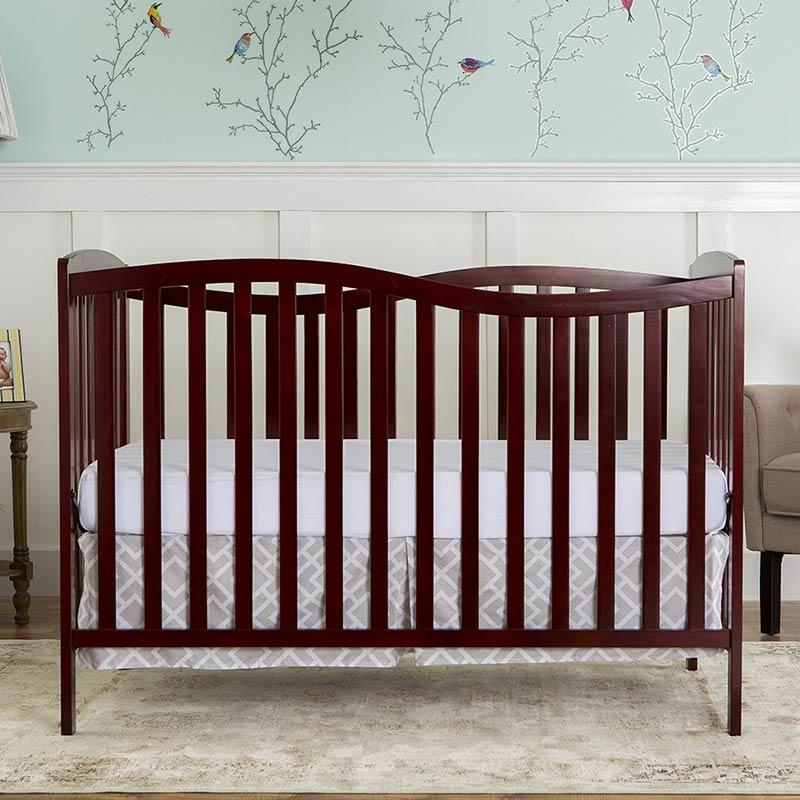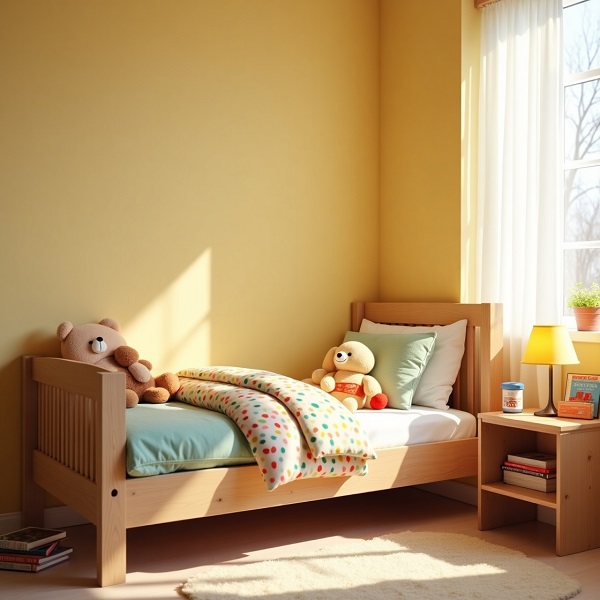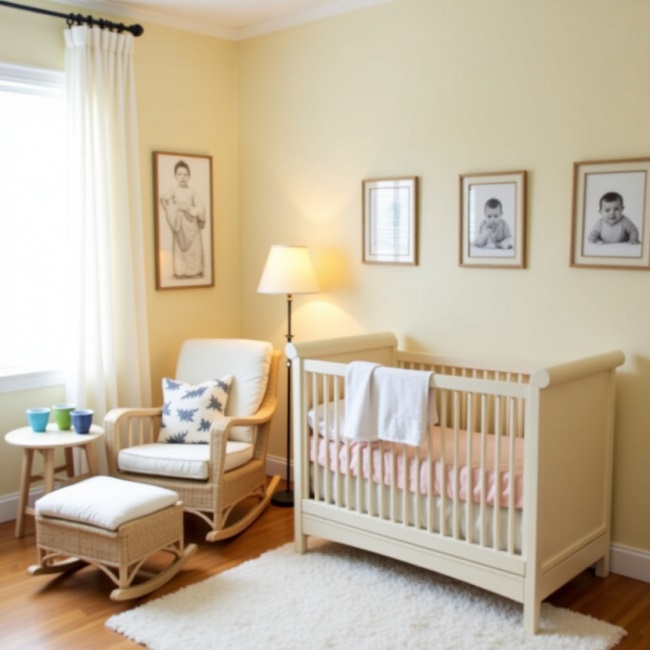Lorsqu'il s'agit de créer un environnement de sommeil sûr et confortable pour votre nouveau-né, choisir entre un berceau et un berceau peut être une décision difficile.
Dans cet article, nous explorerons les principales différences entre un berceau et un couffin, discuterons de la question de savoir si le bébé doit dormir dans un berceau ou un couffin et fournirons des conseils pour choisir la bonne option pour les besoins de votre bébé.
Qu'est-ce qu'un berceau ?
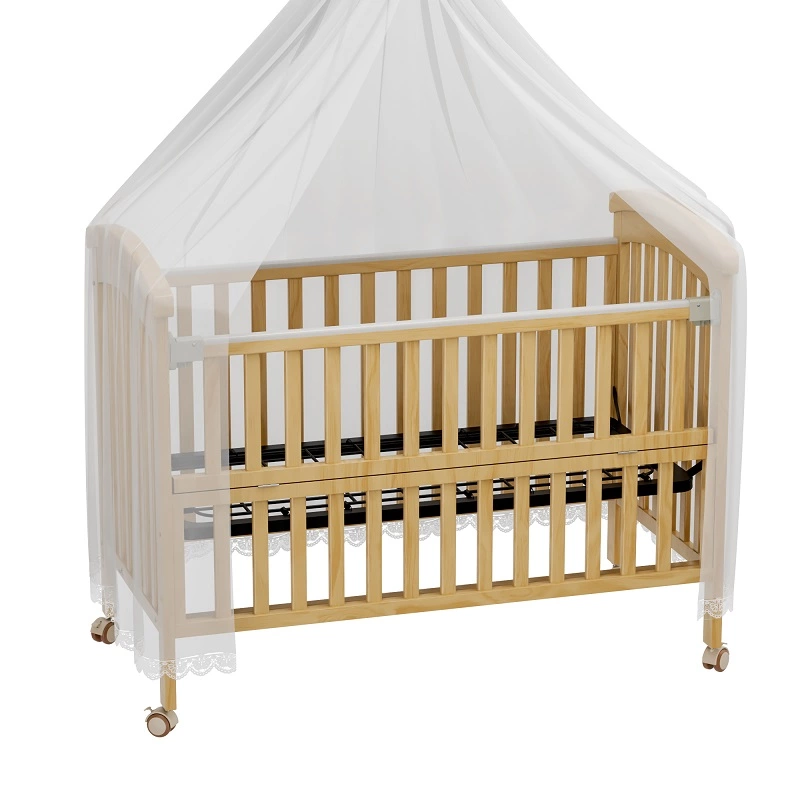
Définition et caractéristiques d'un berceau
Un berceau est un grand lit fermé conçu pour les nourrissons et les tout-petits. Il présente généralement des côtés hauts, une structure robuste et une grande variété de modèles. Ses dimensions standard sont de 52 pouces de long x 28 pouces de large (132 cm x 71 cm).
Les berceaux sont dotés de côtés à lattes pour favoriser la circulation de l'air et la visibilité, ce qui permet aux parents de surveiller facilement leur enfant. Les berceaux modernes comprennent souvent des hauteurs de matelas réglables, ce qui permet aux parents d'abaisser le matelas à mesure que leur bébé grandit et commence à se tenir debout ou à grimper.
De plus, de nombreux berceaux sont dotés de tiroirs intégrés pour le rangement ou d'une table à langer amovible, ce qui enrichit encore la fonctionnalité de cet meubles de chambre d'enfant morceau.
Avantages et inconvénients du berceau
Avantages
- Sécurité et sûreté : Les berceaux sont soigneusement conçus avec des structures robustes et des bords surélevés pour empêcher les bébés de rouler ou de rester coincés. Ils constituent un environnement de sommeil très sûr pour les bébés.
- Utilisation à long terme : De nombreux berceaux sont convertibles, ce qui signifie qu'ils peuvent être transformés en lit pour tout-petit, en canapé-lit ou même en lit double, prolongeant ainsi leur durée de vie au-delà de la petite enfance.
- Confort: Les berceaux offrent aux bébés suffisamment d'espace pour s'étirer et bouger confortablement pendant leur sommeil. Ils offrent une surface de couchage ferme et de soutien qui favorise des habitudes de sommeil saines et un bon alignement de la colonne vertébrale.
- Versatilité: Les berceaux sont disponibles dans une variété de modèles, y compris des options convertibles, des fonctions de cododo, des solutions de rangement, un rangement intégré et bien plus encore.
- Indépendance: Les nourrissons qui dorment dans un berceau dès leur plus jeune âge peuvent avoir une transition plus facile vers un sommeil indépendant à mesure qu’ils grandissent.
Inconvénients
- Coût initial plus élevé : Les berceaux sont souvent plus chers que les autres options de couchage pour nouveau-nés. Les berceaux de haute qualité dotés de certifications de sécurité et de fonctions convertibles peuvent être particulièrement coûteux.
- Besoins en espace : Les berceaux occupent beaucoup d'espace, ce qui peut être un obstacle pour les familles disposant d'un espace de vie limité ou d'une petite chambre d'enfant. Installer un berceau dans une chambre partagée ou un petit appartement peut s'avérer difficile.
- Manque de portabilité : Les berceaux standards sont fixes, encombrants et difficiles à déplacer d’une pièce à l’autre, ce qui les rend inadaptés aux familles qui voyagent.
- Montage et entretien : L'installation d'un lit bébé peut prendre du temps et nécessite des outils. Un entretien régulier, comme le serrage des vis et le nettoyage, est nécessaire pour assurer la sécurité.
Qu'est-ce qu'un berceau ?
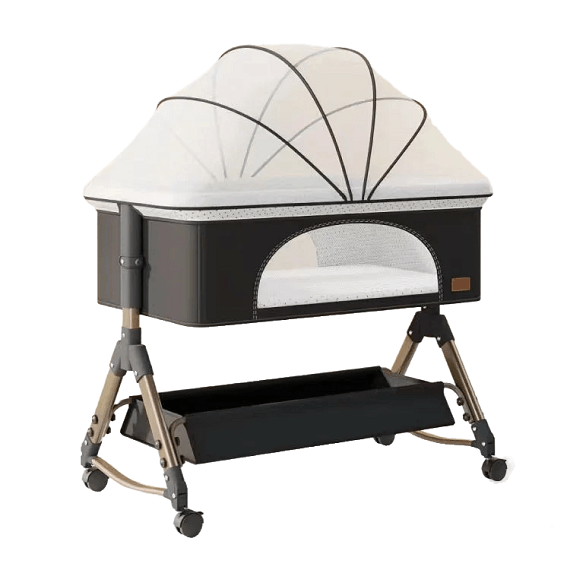
Définition et caractéristiques d'un berceau
Un berceau est un espace de couchage plus petit et plus portable avec des côtés en maille respirante, souvent utilisé pour les nouveau-nés. Il a généralement des côtés plus bas et est conçu pour être placé à côté du lit pour une utilisation nocturne facile.
La plupart des berceaux sont portables, ce qui permet aux parents de les déplacer facilement d'une pièce à l'autre. Cela permet aux parents de garder leur bébé à proximité pendant les tétées nocturnes ou les siestes.
De nombreux berceaux sont conçus avec des fonctions apaisantes pour bébé, manuelles ou automatiques, pour aider à apaiser votre bébé et à l'endormir ou à calmer un bébé qui pleure.
Avantages et inconvénients du berceau
Avantages
- Portabilité: Les berceaux sont légers et faciles à transporter, vous donnant la tranquillité d'esprit de savoir que votre bébé est toujours à vos côtés.
- Conception peu encombrante : Les berceaux sont parfaits pour les petits espaces ou pour les parents qui préfèrent garder leur bébé dans leur chambre pendant les premiers mois.
- Co-dodo : De nombreux berceaux sont conçus pour être fixés sur le côté du lit des parents afin de permettre à bébé de dormir ensemble en toute sécurité. Cela peut favoriser le lien entre le parent et son bébé et rendre l'allaitement nocturne plus pratique.
- Balancement ou vibration doux : Les berceaux dotés de fonctions telles qu'un balancement doux ou des vibrations offrent un confort qui peut aider à apaiser un bébé difficile à dormir.
- Accès facile : Les berceaux ont des côtés bas, ce qui permet aux parents d'atteindre et de prendre facilement leur bébé sans avoir à se pencher ou à faire des efforts. Cela est particulièrement utile pour les mères qui ont eu une césarienne ou qui se remettent d'un accouchement.
Inconvénients
- Utilisation à court terme : Les berceaux sont conçus pour les nouveau-nés et ont souvent une limite de poids ou de taille spécifiée par le fabricant. Les berceaux grandissent relativement vite et deviennent souvent trop grands pour un berceau au cours des premiers mois de vie.
- Problèmes de sécurité : Les berceaux sont souvent moins robustes que les berceaux, ce qui peut présenter un risque pour la sécurité lorsque les bébés deviennent plus actifs et mobiles.
- Moins de flexibilité : Contrairement aux berceaux, qui peuvent être transformés en lits pour tout-petits ou en d’autres meubles, les berceaux n’ont qu’un seul but et ne peuvent pas être réutilisés une fois que les bébés sont devenus trop grands.
- Limitations d'espace : À mesure que les bébés grandissent, les berceaux peuvent ne pas leur offrir suffisamment d'espace pour s'étirer et bouger confortablement. Cela peut être un problème pour les bébés plus grands ou plus actifs.
Différence entre un berceau et un couffin
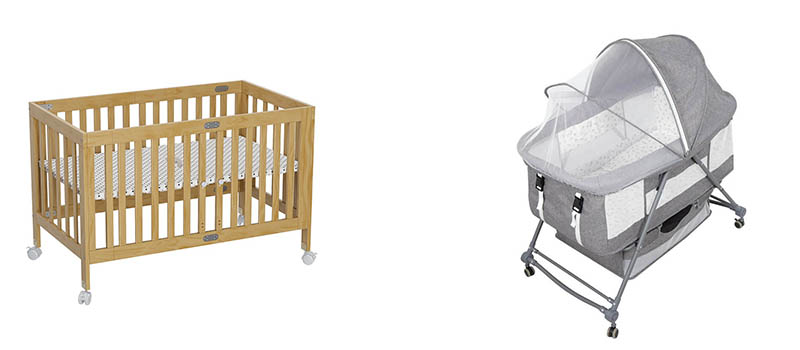
Les berceaux et les couffins peuvent tous deux offrir un environnement de sommeil sûr aux bébés, mais ils diffèrent à bien des égards.
Bien que nous ayons déjà décrit en profondeur les caractéristiques, les avantages et les inconvénients des berceaux et des moïses ci-dessus, cette section utilise une liste pour résumer les différences entre les deux de manière plus systématique et intuitive.
Comprendre ces différences peut aider les parents à prendre une décision éclairée en fonction de leur style de vie et du confort et de la sécurité de leur bébé.
| Fonctionnalité | Berceau | Berceau |
| Taille | Plus grand, prend plus de place | Nouveau-nés jusqu'à 4-6 mois |
| Portabilité | Fixe, immobile | Léger et facile à déplacer |
| Stockage | Peut inclure des options de stockage intégrées | Stockage limité, mais certains modèles incluent de petites poches |
| Coût | Généralement plus élevé en raison de la taille et des fonctionnalités | Coût généralement inférieur, idéal pour une utilisation à court terme |
| Versatilité | Souvent convertible en lit pour tout-petits ou en lits de repos | Polyvalence limitée, utilisé uniquement comme espace de sommeil pour nouveau-né |
| Poids | Plus lourd et plus volumineux | Plus léger, plus facile à transporter ou à déplacer |
| Adaptabilité pour les parents | Peut nécessiter de se pencher pour interagir avec bébé | Souvent positionné à une hauteur pratique pour une interaction facile |
Facteurs à prendre en compte lors du choix
Les bébés passent la majeure partie de leur temps à dormir, et même si la fonction ultime des différents produits est la même, pour le confort des enfants et l'harmonie des familles parentales, il est raisonnable de passer un peu plus de temps à réfléchir à l'outil de sommeil qui convient le mieux à votre bébé.
Voici les facteurs que vous devez prendre en compte lors de votre choix :
Âge du bébé
Un berceau convient aux nouveau-nés de moins de 4 à 6 mois. Il offre un environnement confortable et chaleureux aux bébés qui ne se sont pas encore retournés ou relevés. Un lit bébé convient à une utilisation de la naissance à la petite enfance et offre plus d'espace.
Disponibilité de l'espace
Un berceau est parfait pour les familles vivant dans des petits espaces comme des appartements. Sa taille compacte lui permet de s'intégrer dans une chambre à coucher avec un espace limité. Un berceau nécessite plus d'espace, en particulier un berceau de taille normale, il est donc plus adapté aux chambres d'enfants plus grandes.
Budget
Si vous avez un budget limité en ce moment, choisir un berceau est une bonne solution, généralement moins cher qu'un lit bébé.
Préférence pour le cododo
Si vous souhaitez pouvoir prendre soin de votre bébé et l'allaiter à tout moment, optez pour un berceau. De nombreux berceaux sont conçus pour le co-dodo et les panneaux latéraux peuvent être abaissés pour faciliter l'accès du bébé.
Plan d'utilisation
Si vous envisagez d'acheter un berceau pour bébé à long terme ou si vous ne souhaitez pas acheter trop de meubles pour bébé, il est recommandé de choisir un berceau qui convient toujours aux bébés après 6 mois, sans avoir à acheter de nouveaux accessoires de couchage. Une fois que le bébé grandit et n'est plus adapté au berceau, ses caractéristiques robustes et durables peuvent également vous aider à le transmettre à l'enfant suivant.
Styles de berceaux et de couffins conviviaux recommandés
Styles de berceaux
Berceaux convertibles : Les berceaux convertibles sont polyvalents et peuvent être transformés en différents types de lits, comme un lit pour tout-petit, un canapé-lit ou même un lit double. Vous pouvez choisir un berceau 3 en 1, un berceau 4 en 1 ou un berceau 5 en 1, selon vos besoins.
Mini berceaux : Les mini-berceaux sont plus petits que les berceaux standards et sont idéaux pour les petites chambres d'enfants ou les maisons avec un espace limité. Ils sont de plus en plus utilisés comme deuxième berceau pour les voyages ou dans les chambres d'amis.
Berceaux réglables : Les berceaux réglables sont dotés d'un matelas réglable en hauteur pour s'adapter à la croissance et au stade de développement de votre bébé. Recherchez un berceau avec plusieurs réglages de hauteur de matelas qui peuvent être facilement ajustés sans outils ni assemblage compliqué.
Styles de berceaux
Berceaux cododo : Ces berceaux pour bébé sont conçus pour s'abaisser d'un côté du lit adulte, vous permettant d'être aussi près de votre bébé que vous le nourrissez et l'apaisez pendant la nuit tout en conservant une surface de couchage séparée.
Berceaux portables : Les berceaux portables sont légers et ont souvent des caractéristiques telles qu'un cadre pliable ou des poignées de transport, ce qui les rend faciles à déplacer dans la maison ou à emporter avec vous en voyage.
Berceau pivotant ou à bascule : Ces berceaux sont dotés d'une fonction de bascule ou de balancement intégrée qui apaise doucement les bébés pour les endormir, et le mouvement imite le rythme réconfortant d'être tenu ou bercé, ce qui peut calmer les bébés.
Berceaux intelligents : Les berceaux intelligents utilisent la technologie pour aider à apaiser les bébés. Certains modèles incluent un basculement automatique, des vibrations ou des berceuses, tandis que d'autres sont dotés d'applications permettant de suivre les habitudes de sommeil ou de surveiller les bébés.
Berceaux de parc : UN berceau pour parc est un produit deux en un qui peut être utilisé à la fois comme couffin et comme parc. Il est souvent doté d'un insert de couffin amovible pour les nouveau-nés, et le parc peut ensuite être utilisé comme espace de jeu à mesure que le bébé grandit.
Quand et comment un bébé passe-t-il d’un berceau à un lit d’enfant ?
Quand faire la transition ?
L'âge auquel les bébés passent du berceau au lit d'enfant peut varier. La plupart des bébés deviennent trop grands pour un berceau entre 4 et 6 mois ou lorsqu'ils atteignent la limite de poids fixée par le fabricant.
À mesure que les bébés grandissent, certains deviennent plus actifs et agités. Les berceaux ont généralement des côtés plus bas que les lits à barreaux et offrent moins d'espace. Si votre bébé se retourne, se met à quatre pattes ou montre des signes d'essayer de sortir du berceau, il est temps de passer à un berceau.
Comment faire la transition ?
Commencez par laisser votre bébé faire la sieste dans son berceau pour l'aider à s'adapter à son nouvel environnement de sommeil. Familiarisez-le avec le confort et la taille du berceau.
Aidez votre bébé à développer un sentiment de familiarité avant d'aller au lit, par exemple en lui lisant un livre, en lui chantant une berceuse ou en utilisant un objet réconfortant. La régularité aidera votre bébé à se sentir à l'aise.
Soyez patient pendant la transition. Ils sont nouveaux dans ce monde et tout prend du temps pour s'adapter. Vous devez être persévérant et encourageant.
Conclusion
Choisir entre un berceau et un couffin pour les besoins de sommeil de votre bébé est une décision personnelle qui dépend de divers facteurs. Comprendre les différences, les avantages et les inconvénients de chaque option peut vous aider à faire un choix éclairé.
En pesant ces facteurs et en explorant les styles conviviaux des berceaux et des berceaux, vous pouvez créer un environnement de sommeil sûr et confortable pour votre tout-petit.
Articles connexes recommandés :

